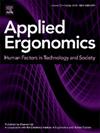Exploring police ergonomics: Effects of personal protective equipment, holster position and perceived discomfort on different gait intensities
IF 3.1
2区 工程技术
Q2 ENGINEERING, INDUSTRIAL
引用次数: 0
Abstract
Objectives
This study investigated the impact of personal protective equipment (PPE) and holster positions on gait kinematics and discomfort in Brazilian police officers.
Methods
A crossover study included 20 active-duty police officers assessed two-dimensional kinematic and self-reported data. Three PPE use conditions (control, PPE + thigh holster, PPE + hip holster) were investigated during walking and sprint acceleration.
Results
PPE use increased stride length and gait speed in the weapon side compared to the free side during walking and reduced the stride length of the free side during sprint acceleration. PPE also increased back and knee discomfort during walking, with sprint acceleration proving more comfortable for the knee when using a thigh holster compared to a hip holster.
Conclusion
PPE significantly affects gait mechanics and discomfort, especially during sprinting. Holster placement is critical to officer mobility and comfort, emphasizing the need for ergonomic improvements in PPE design.
探索警察人体工程学:个人防护装备、枪套位置和感知不适对不同步态强度的影响。
目的:本研究调查了个人防护装备(PPE)和枪套位置对巴西警察步态运动学和不适的影响。方法:一项交叉研究包括20名现役警察评估二维运动学和自述数据。研究了3种PPE使用条件(对照、PPE +大腿皮套、PPE +臀部皮套)在行走和冲刺加速过程中的作用。结果:与自由侧相比,PPE的使用增加了行走时武器侧的步幅长度和步态速度,并减少了冲刺加速时自由侧的步幅长度。PPE还增加了走路时背部和膝盖的不适,在冲刺加速时,使用大腿皮套比使用臀部皮套对膝盖更舒适。结论:PPE显著影响步态力学和不适感,尤其是短跑时。枪套的位置对警官的机动性和舒适性至关重要,强调了PPE设计中人体工程学改进的必要性。
本文章由计算机程序翻译,如有差异,请以英文原文为准。
求助全文
约1分钟内获得全文
求助全文
来源期刊

Applied Ergonomics
工程技术-工程:工业
CiteScore
7.50
自引率
9.40%
发文量
248
审稿时长
53 days
期刊介绍:
Applied Ergonomics is aimed at ergonomists and all those interested in applying ergonomics/human factors in the design, planning and management of technical and social systems at work or leisure. Readership is truly international with subscribers in over 50 countries. Professionals for whom Applied Ergonomics is of interest include: ergonomists, designers, industrial engineers, health and safety specialists, systems engineers, design engineers, organizational psychologists, occupational health specialists and human-computer interaction specialists.
 求助内容:
求助内容: 应助结果提醒方式:
应助结果提醒方式:


